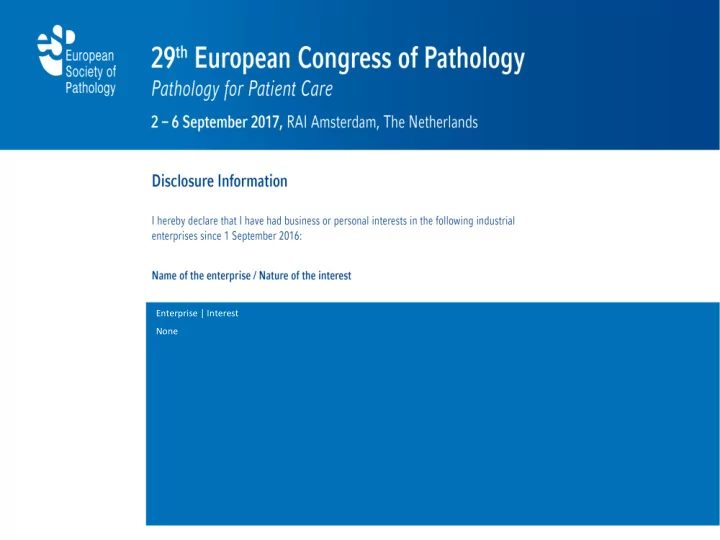

Enterprise | Interest None
Epigenetics and prostate cancer Defining the timing of DNA methyltransferases deregulation during prostate cancer progression Vassiliki Tzelepi 1 , Souzana Logotheti 1 , Efthymia Papakonstantinou 1 , Ioannis Maroulis 2 , Maria Melachrinou 1 Vassiliki Zolota 1 Departments of 1 Pathology and 2 Surgery, Medical School, University of Patras, Patras, Greece
Epigenetics • Alterations in DNA expression without any changes in DNA sequence DNA methylation Post-transcriptional histone modifications microRNAs expression Chen et al. ONCOLOGY REPORTS 31: 523-532, 2014
DNA methylation Α covalent chemical modification resulting in addition of a methyl group at the carbon 5 position of the cytosine ring in CpG dinucleotides DNA methyltransferases (DNMTs) DNMT1 DNMT2 DNMT3 Α DNMT3 Β DNMT3L Gravina et al. Molecular Cancer 9:305, 2010
DNA methyltransferases DNMT1: maintenance of basal methylation, passage of methylation to the daughter cells, methylation during cell proliferation DNMT2: tRNA methylation, role in DNA methylation? DNMT3 Α De novo methylation DNMT3 Β DNMT3L
Prostate Cancer Tosoian et al. Nature Reviews Urology 13:205 – 215, 2016
Prostate cancer-therapy Castration Resistant Prostate Cancer-CRPC Watson et al Nat Rev Cancer. 15:701 – 711, 2015
Neuroendocrine prostate cancer Synaptophysin Small cell carcinoma Androgen Receptor Low PSA (for the extent of the disease) Visceral metastases Osteolytic bone metastases NO AR expression, no response to hormonal therapy Initially responds to chemotherapy, but resistance emerges VERY AGGRESSIVE
Prostate cancer and methylation • CpG island hypermethylation in various genes in PCa cell lines and tissues • Increased DNMTs’ enzyme activity in PCa cell lines • Higher DNMT1 expression in androgen independent PCa cell lines • Opposing roles of DNMT1 in early and late stage PCa in murine models • DNMTs downregulation or pharmaceutical inhibition reduces tumor growth in PCa cell lines
Unsupervised analysis of genome wide CpG methylation CpG methylation CpG methylation “Methylation status is complementary to morphology to discriminate AR dependent and independent CRPC” Beltran H et al. Nat Med. 2016 22(3):298305 Kleb et al Epigenetics, 2016
DNMTs in human PCa tissues • Higher DNMT1 expression in cancer tissues compared to BPH (20 samples) and in high Gleason Score compared to low Gleason Score localized tumors (40 samples, 56 samples) • Gradual increase of DNMT1 from normal to metastatic PCA (90 samples) • No correlation of DNMT3b to Gleason Score (40 samples)
Hypothesis DNA methyltransferases are implicated in prostate cancer progression and the emergence of aggressive phenotypes
Objective Elucidate the role of DNMTs in prostate cancer progression in an effort to identify prognostic markers and potential therapeutic targets
244 patients with prostate cancer Low grade prostate cancer (GS: 6, 7(3+4), Prognostic Grade Group 1,2) High grade prostate cancer (GS: ≥7 (4+3), Prognostic Grade Group 3,4,5) Prostate cancer treated with androgen ablation Castrate Resistant Prostate Cancer Neuroendocrine prostate carcinoma received prostatectomy at MD Anderson cancer center
Tissue microarrays • All slides were reviewed, representative areas were selected and tissue microarrays were constructed. – 0,6mm tissue cores (non-neoplastic peripheral zone and neoplasm) – 3069 cores (2637 neoplastic and 432 non- neoplastic) from 350 blocks – 2-17 cores per patient (mean: 6, SD: 3, median: 5) – 6 TMA blocks
Immunohistochemistry DNMT1 DNMT2 DNMT3b Company/ Santa Cruz, Santa Cruz, Abcam, clone Heidelberg, Heidelberg, Cambridge, UK Germany, H-12 Germany, H-271 52A1018 (Mouse monoclonal) (Rabbit polyclonal) (Mouse monoclonal) Antigen EDTA, pH:8 Citrate, pH:6 EDTA, pH:8 retreival Dilution 1:50 1:150 1:250 Incubation 2 hours overnight 30 minutes time Detection Envision, Dako, Glostrup, Denmark System Positive Lymph node Placenta Testicle control
Pannoramic Desk Scanner Pannoramic Viewer 3DHistech, Budapest, HUNGARY
Evaluation Nuclear staining Cytoplasmic staining when present • % percentage of positive cells (0%, 5%, 10% and then in 10% Multiply increments ) (0-300) • Intensity of staining (1+, 2+, 3+)
Statistical analyses • Non parametric tests – Mann-Whitney Test for non paired samples – Wilcoxon test for paired samples • IBM Corp. Released 2013. IBM SPSS Statistics for Windows, Version 22.0. Armonk, NY: IBM Corp., • Statistical significance p<0,05
Results
DNMT1 • Nuclear staining p=0.031 Std. Mean Deviation p=0,009 non 20 26 neoplastic LOW GRADE 21 33, p<0,001 HIGH GRADE 47 31 TREATED 61 52 CRPC 59 53 NECA 104 70
Low grade Non-neoplastic High grade DNMT1
CRPC NECA DNMT1
DNMT2-nuclear staining Std. Mean Deviation non neoplastic 28 33 LOW GRADE 42 34 HIGH GRADE 46 30 TREATED 94 42 CRPC 80 31 p<0.001 NECA 87 48
DNMT2 Cytoplasmic staining Mean Std. Deviation LOW GRADE 76 26 HIGH GRADE 72 20 TREATED 78 20 CRPC 81 13 NECA 60 31
Non-neoplastic Low grade DNMT2 nuclear High grade
treated CRPC DNMT2 nuclear
DNMT3b Std. Mean Deviation non neoplastic 19 17 LOW GRADE 30 39 HIGH GRADE 18 21 p<0.001 TREATED 21 41 CRPC 110 70 NECA 160 37
High grade Low grade DNMT3b CRPC NECA
Conclusions • Different DNMTs are deregulated at different times during prostate cancer progression • DNMT1 is gradually upregulated relatively early during PCa progression with significant elevation in NECa • DNMT2 is upregulated as a response to androgen ablation therapy • DNMT3b is upregulated after the emergence of castration resistance
Implications DNMT3b may be a promising therapeutic target for CRPC Both DNMT1 and DNMT3b may be promising therapeutic targets for NECa
Future perspectives • Analyze the expression of DNMT3a and DNMT3L across the spectrum of prostate cancer progression • Define the functional role of DNMTs’ deregulation
Acknowledgements • Maria Roumelioti (Department of Pathology, University of Patras) • Patricia Troncoso, MD (Department of Pathology, MADCC) • Eleni Efstathiou, MD, PhD (Department of GU Medical Oncology, MADCC) • Ana Aparicio, MD (Department of GU Medical Oncology, MADCC) • Anh Hoang (Department of GU Medical Oncology, MADCC) • Ina Prokhorova (Department of Pathology, MADCC)
Funding • Grant E-657 from the Research Committee of the University of Patras via “K. Karatheodori ” program • MDACC-UPATRAS collaborative research, E- 421, Research Committee of the University of Patras
Recommend
More recommend